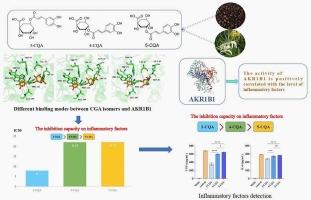与 AKR1B1 抑制作用有关的天然绿原酸异构体抑制 LPS 诱导的 RAW264.7 细胞炎症反应
IF 3.3
3区 医学
Q2 BIOCHEMISTRY & MOLECULAR BIOLOGY
引用次数: 0
摘要
炎症是免疫系统对损伤或感染的生理反应,通常表现为局部组织充血、肿胀、发热和疼痛。长期或过度的炎症会导致组织损伤和多种疾病的发生。天然成分的抗炎作用已得到广泛的研究和证实。本研究调查了绿原酸(CGA)异构体--3-咖啡酰奎宁酸(3-CQA)、4-咖啡酰奎宁酸(4-CQA)和 5-咖啡酰奎宁酸(5-CQA)--对 RAW264.7 细胞中 LPS 诱导的炎症反应和氧化应激反应的影响。总体而言,3-CQA 对 TNF-α、IL-6、NO 和 ROS 水平的降低最为显著。与 5-CQA 相比,4-CQA 对 TNF-α 的抑制作用更强(p < 0.05),而对其他参数的抑制作用则无明显差异。我们进一步使用 DARTS 和 CETSA 证明了 CGA 异构体与 AKR1B1 具有稳定的亲和力。作为阳性对照,AKR1B1 拮抗剂 epalrestat 与 CGA 异构体表现出相似的效果。3-CQA对AKR1B1的半抑制浓度(IC50)最小,而4-CQA和5-CQA的半抑制浓度值相似。对接构象的 AutoDock 模拟显示,CGA 异构体的平均结合能差异极小。主要差异在于 VAL47 与 3-CQA 形成氢键,而 GLN49 与 4-CQA 和 5-CQA 形成氢键。此外,涉及 PHE122 和 LEU300 的疏水键数量也各不相同。我们的结论是,非共价相互作用的差异导致 CGA 异构体对 AKR1B1 的抑制能力不同,从而进一步影响了 CGA 异构体的抗炎和抗氧化作用。本文章由计算机程序翻译,如有差异,请以英文原文为准。

Inhibition of LPS-induced inflammatory response in RAW264.7 cells by natural Chlorogenic acid isomers involved with AKR1B1 inhibition
Inflammation is the physiological response of the immune system to injury or infection, typically manifested by local tissue congestion, swelling, heat, and pain. Prolonged or excessive inflammation can lead to tissue damage and the development of many diseases. The anti-inflammatory effects of natural ingredients have been extensively researched and confirmed. This study investigated the effects of Chlorogenic acid (CGA) isomers —— 3-Caffeolyquninic acid (3-CQA), 4-Caffeolyquninic acid (4-CQA), and 5-Caffeolyquninic acid (5-CQA) —— on the inflammatory response and oxidative stress reaction induced by LPS in RAW264.7 cells. Overall, 3-CQA exhibited the most significant reduction in levels of TNF-α, IL-6, NO, and ROS. 4-CQA showed superior inhibition of TNF-α compared to 5-CQA (p < 0.05), while no significant difference in other parameters. We further used DARTS and CETSA to demonstrate that CGA isomers have stable affinity with AKR1B1. As a positive control, the AKR1B1 antagonist epalrestat exhibited similar effects to the CGA isomers. 3-CQA having the smallest half-inhibitory concentration (IC50) for AKR1B1, while 4-CQA and 5-CQA have similar values. AutoDock simulations of the docking conformations revealed minimal differences in the average binding energies of the CGA isomers. The main differences were that VAL47 formed a hydrogen bond with 3-CQA, whereas GLN49 formed hydrogen bonds with 4-CQA and 5-CQA. Additionally, the number of hydrophobic bonds involving PHE122 and LEU300 varies. Our conclusion is that differences in non-covalent interactions result in the varying inhibitory abilities of CGA isomers on AKR1B1, which further affect the anti-inflammatory and antioxidant effects of CGA isomers.
求助全文
通过发布文献求助,成功后即可免费获取论文全文。
去求助
来源期刊

Bioorganic & Medicinal Chemistry
医学-生化与分子生物学
CiteScore
6.80
自引率
2.90%
发文量
413
审稿时长
17 days
期刊介绍:
Bioorganic & Medicinal Chemistry provides an international forum for the publication of full original research papers and critical reviews on molecular interactions in key biological targets such as receptors, channels, enzymes, nucleotides, lipids and saccharides.
The aim of the journal is to promote a better understanding at the molecular level of life processes, and living organisms, as well as the interaction of these with chemical agents. A special feature will be that colour illustrations will be reproduced at no charge to the author, provided that the Editor agrees that colour is essential to the information content of the illustration in question.
 求助内容:
求助内容: 应助结果提醒方式:
应助结果提醒方式:


